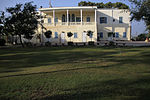Battle of Nitzanim

The Battle of Nitzanim was a battle fought between the Israel Defense Forces and the Egyptian Army in the 1948 Arab–Israeli War, on June 7, 1948 (29 Iyar, 5708 in the Hebrew calendar). It was the first major Egyptian victory of the war, and one of the few cases of Israeli surrender. The battle began on the night of June 6–7 with an artillery bombardment of Nitzanim, followed by an aerial bombardment and armored and infantry attacks. The main attack broke through the Israeli defenses at around 11:00; the Israelis retreated to a second position, and finally to a third position at 14:00. At 16:00, 105 Israelis surrendered to the Egyptian Army. Between June 7 and 10, the Battle of Hill 69 was fought nearby. The hill was captured by the Egyptians after a disorganized Israeli retreat. Israelis viewed the surrender of Nitzanim as a humiliation, especially after the Givati Brigade published a leaflet denouncing the defenders. The residents of Nitzanim demanded a probe into the battle, and one was conducted by the General Staff, siding with the residents and coming to the conclusion that surrender was justified.
Excerpt from the Wikipedia article Battle of Nitzanim (License: CC BY-SA 3.0, Authors, Images).Battle of Nitzanim
Hof Ashkelon Regional Council
Geographical coordinates (GPS) Address Nearby Places Show on map
Geographical coordinates (GPS)
| Latitude | Longitude |
|---|---|
| N 31.7175 ° | E 34.635555555556 ° |
Address
Hof Ashkelon Regional Council
South District, Israel
Open on Google Maps










